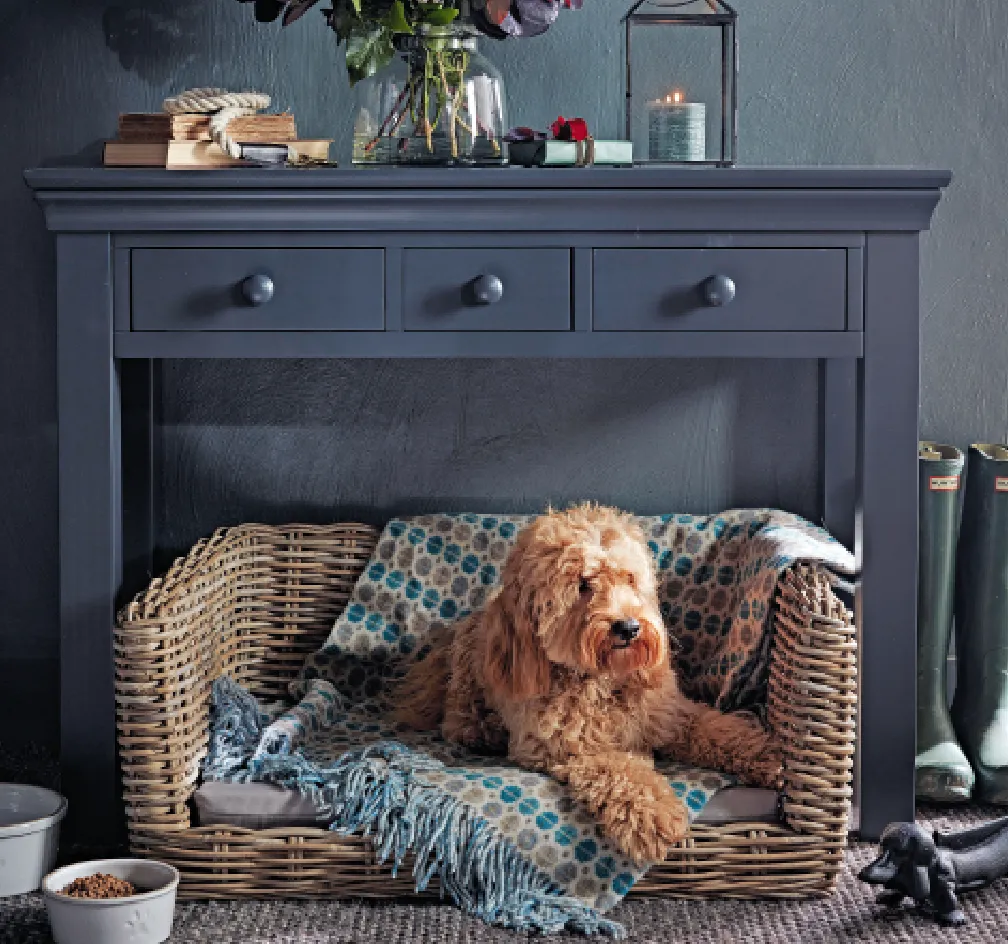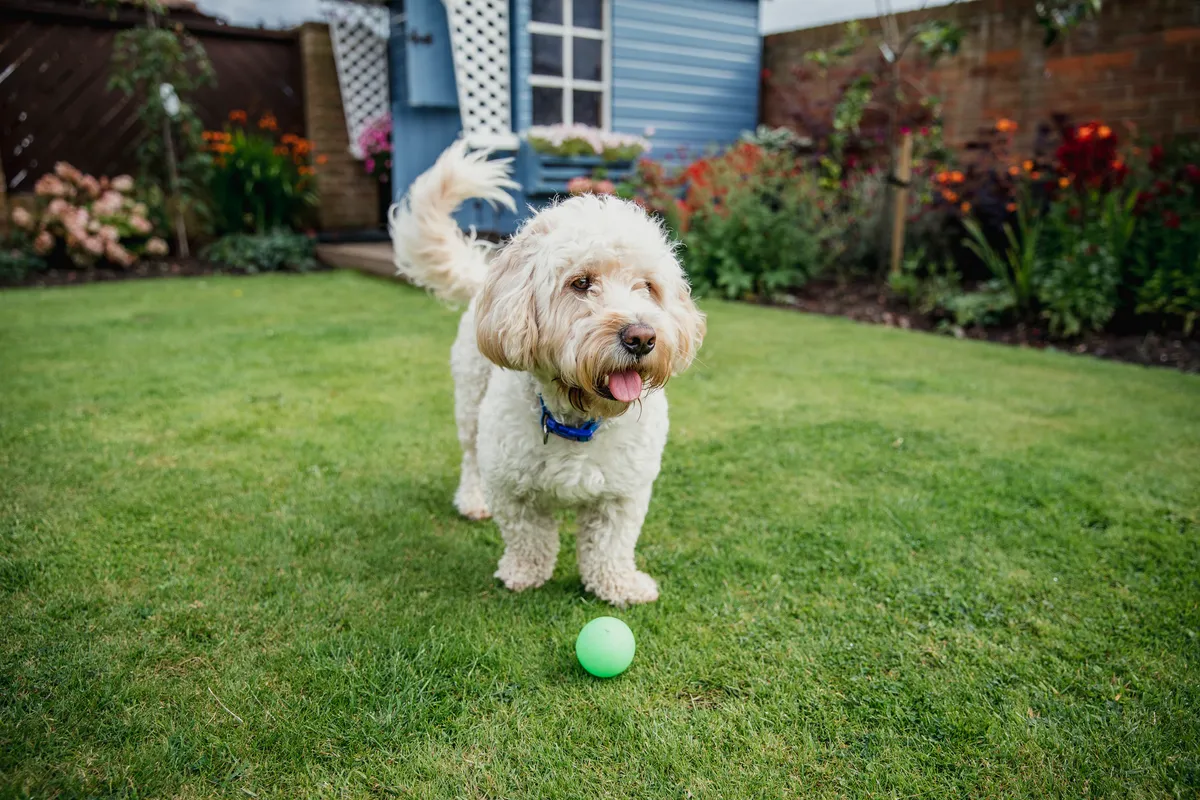We’ve always been a nation of animal lovers, but with so many people welcoming new dogs over lockdown, it’s time to think about how to make your home a safe and cosy place for every member of the family, including dogs. Pet-proofing your home is essential in keeping your dog out of harm’s way and that can be nerve-wracking if you’re a first-time dog owner. But don’t worry, we’ve done the research for you to make your home both safe and stylish for all the family, including the furry ones!
How to make your house dog friendly
- Creating a special corner in your home will help to discipline pets from damaging your furniture. Being kept in the doghouse can be a good thing for a puppy, as crate training is seen as the most effective solution and keeps them in one spot when you’re out. Crates can be ugly but there are now functional and stylish ones available that will fit right in with the rest of your décor. Once your pet is trained, look for furniture that incorporates a pet bed so they can feel part of the family home.
Visitors coming into the home can sometimes cause anxiety in our pets, therefore it's a good idea to create a safe and quiet space for them'
Dr Samantha Butler-Davies, Veterinary Clinical Services Manager at Vets4Pets
- Choose flooring that is easy to clean. Avoid hardwood floors that dent or scratch easily. Laminate flooring, LVT, stone or ceramic tiles are all hardwearing, easy to clean options that can withstand the odd little accident or muddy pawprint.
- Brushing your pet (ideally outdoors) regularly will help cut down on shed hair on carpets and furniture. Opt for a specially designed pet-friendly vacuum. If you have carpets, consider getting a spot washer or carpet cleaner to remove stains.
- Avoid the drama of a muddy pet running around your home after a dog walk by creating a space near the entrance to clean them off. If you have the space and budget, consider installing a boot room or porch in which to wash and dry your dog before they can enter the home. Alternatively, create an outside area near the back door where you can hose your muddy dog down. Store pet wipes, towels and brushes in a cupboard at the dedicated entrance to keep all your pet cleaning essentials close to hand.

- An essential part of pet-friendly interior design must surely be the addition of your furry friend’s very own comfy bed. Find a design that blends with your décor and is made of high-quality materials that are easy to clean. Keep your kitchen floor free of trip hazards by placing pet beds and food bowls in a quiet corner of the room, away from the working triangle. If you’re planning on installing a new kitchen, many companies now offer designs that allow you to incorporate a place for your pet’s bed or eating area within the cabinetry or island unit.
- If you’re out of the house during the day, consider fitting a pet camera so you can keep an eye on your pet and make sure they’re okay. Most work via an app and allow you to monitor, and even talk to them, from your mobile phone.
- When decorating with pets in mind, don’t overlook what you put on the walls – they could become a headache to clean if you don’t consider their texture. A highly-textured wall, such as flock, Anaglypta or Artex, will attract pet fur, even if your pet isn’t rubbing against it. Choose a tough, wipeable satin or a semi-gloss paint, which will help to repel fur and will be easy to clean and keep clear of mud splatters so your walls stay glistening.
How to create a dog-friendly garden

Carol Adams, Head of Horticulture and Biodiversity at Trentham, says…
Include a grass lawn with some shade to let your dog stretch, roll and play, or enjoy a summer paddling pool and hose pipe to cool off. Avoid using loose gravel surfaces interfacing with grass or steps, as it will tend to travel onto unwanted areas when your dog is running around playing. These can also be a safety issue with puppies who will try to eat them. When selecting paving, avoid dark-coloured tiles as these can become very hot in full sun.
Solid and suitable high fencing is also important. Depending on your dog, you can still make the garden hedgehog-friendly with small hedgehog-sized gaps in the panel on either side to grant these endangered animals access through your garden to your neighbours’ plots.
You see a lot of artificial turf surfaces used in ‘easy care’ gardens, but these aren’t good for biodiversity, or as an enriching experience for your four-legged family member.
Some breeds enjoy digging and depending on the scale of your garden this can be allowed in an area of rough lawn. Avoid bulbs or herbaceous plants, which may have toxic underground tubers or fleshy roots – The Dogs Trust has a good list you can refer to.
At Trentham, as a dog-friendly attraction, we use lots of different grass varieties to ensure our gardens can accommodate our furry visitors. This includes Molina, Deschampsia and Miscanthus teamed with herbaceous perennials to create relaxing prairie-like plantings. You could mix grasses with heathers and heaths for a robust all year-round display, too.
Georgina Read, Director at Paving Superstore has these quick 'dos' and 'don'ts' for creating a dog-friendly garden
- Do consider adding trees for shelter from weather and shade from the sun
- Do use strong robust plants, such as tall grasses and bamboos, that can handling light tramping or gnawing
- Do consider a lighter-coloured patio stone, as this is favourable for those paws when it gets hot
- Do create a water feature so your dog can take an occasional slurp, and (if space permits) build a natural pond for your dog to wade into
- Do introduce a bark area within a large planting bed, as these are often adopted by your dog for toilet activities (saving your prized plants)
- Don't introduce poisonous plants into the garden. These include, but are not limited to: Aconitum, amaryllis bulbs, asparagus fern, azalea, bluebells, cyclamen, daffodil bulbs, day lilies, delphiniums, dog’s mercury (Mercurialis perennis), foxgloves, hemlock, hyacinth, hydrangea, ivy, laburnum, lily of the valley, lupins, morning glory, nightshade, oleander, rhododendron, rhubarb leaves, sweet pea, tulip bulbs, umbrella plant, wisteria, yew.
11 common garden plants that are poisonous to cats
- Don't replace all your grass with hard-standing – instead of trying to keep a natural lawn looking its best, consider replacing it with fake grass

